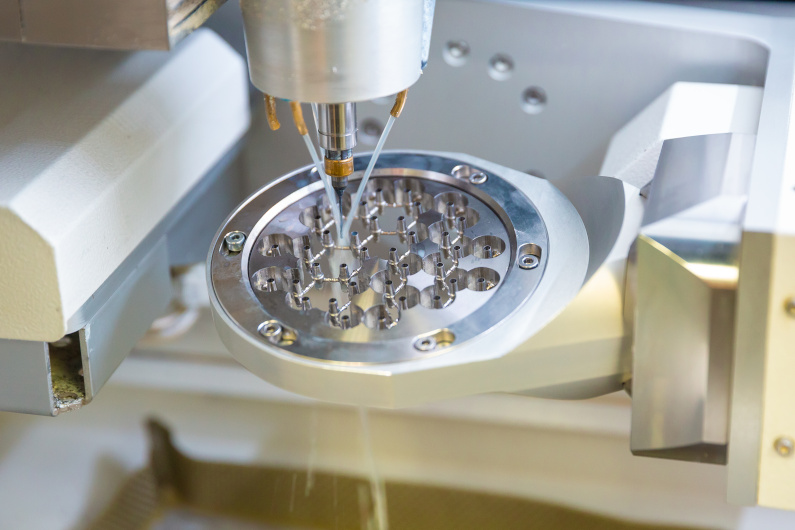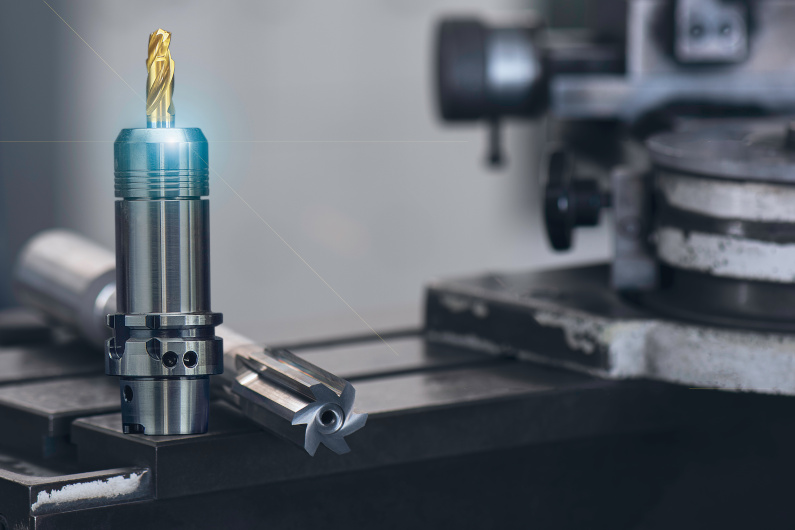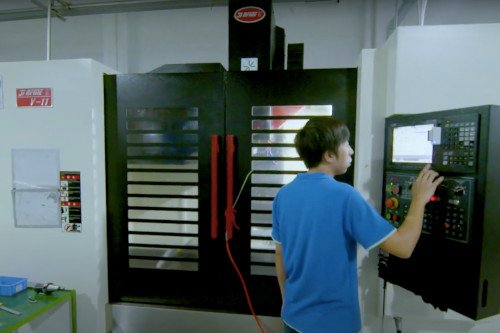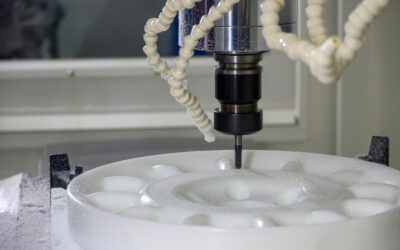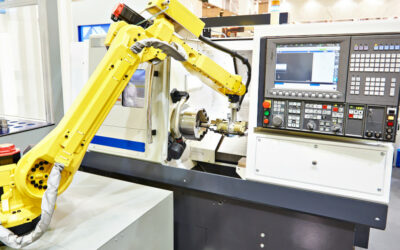Titanium is an amazing material with some truly outstanding properties. It has a very high strength, is lightweight, is resistant to corrosion and chemicals, and can even maintain its strength when exposed to incredibly high temperatures.
Unfortunately, some of the properties that make it so unique and valuable to product designers also make machining titanium incredibly difficult.
This article will help you understand the challenges of machining titanium and some tips on how to machine titanium more effectively. We’ve also assembled a list of some of the best titanium grades for machining applications.
Why is Titanium Hard to Machine?
There is no singular property that makes titanium harder to machine than other materials. Instead, a combination of different properties work together to make most conventional machining tactics ineffective. By understanding what these challenges are, metallurgists and machinists can find solutions processing solutions that lead to high-quality machined titanium parts.
Heat Accumulation
One of the biggest obstacles to machining titanium is keeping everything cool. Titanium’s low thermal conductivity makes the metal workpiece rapidly accumulate heat at the tooling location. This increases the wear on machining tools and has the secondary effect of hardening the titanium, which then further exacerbates the tool wear. If not addressed, this can detrimentally affect the quality of cut surfaces.
“Gummy” Material
As if that wasn’t enough, the low modulus of elasticity of titanium compared to its high strength makes it a “gummy” material to machine and can lead to severe chatter. This can result in galling of cut titanium, which adheres to tooling. Additionally, chatter and titanium’s springback effect at the cut location create poor machining conditions. These hurdles can further increase tool wear and can compromise finished surface quality.
Elastic Deformation
Lastly, depending on the design of the part, the elastic behavior of titanium can also make unsupported portions of a workpiece elastically deform out of position. The part bends away from the forces created by cutting tools, then returns to its normal position after the cutting tool passes, creating final parts that are out of tolerance.
3 Useful Tips for Machining Titanium
The challenges of titanium machining are enough to make many machine shops wary of working with this advanced material. But its outstanding properties mean more and more product designers are looking to have quality parts made from titanium. Luckily, expert machinists and tooling suppliers have come up with a few key ways to make machining titanium at least a little bit easier.
Tip 1 – Use the Right Tool
With the growing popularity of titanium, tool designers are coming up with unique solutions for improving the machinability of titanium. Advanced materials, like heat-resistant titanium aluminum nitride (TiAlN) or titanium carbo-nitride (TiCN) coated tooling, can extend tool lifetimes. Meanwhile tooling with uneven spacing between cutting edges can disrupt the constructive interference that leads to tool chatter.
Overall, machinists should choose high-quality tools designed for use with titanium, and they should frequently inspect and replace dull tools. Also consider using a smaller diameter tool with a larger number of cutting edges. This helps to maintain metal removal rates while reducing heat accumulation.
Tip 2 – Stabilize Your Setup
Titanium is already prone to causing tool chatter, so anything you can do reduce vibration will make machining titanium easier. Ensure parts are well-supported and secured to prevent deflection in the workpiece. Use high-quality CNC machines with very stiff tooling arrangements. You can even consider using shorter cutting tools to reduce tool deflection.
Tip 3 – Adjust Cutting Parameters
Machining titanium requires careful temperature management. One of the most obvious ways to keep the workpiece and tooling cool is to apply consistent, high-pressure coolant directed to the cut area. Blasting the chips out of the cut area also keeps them from adhering to your machining tools.
With titanium it’s also important to be very intentional about feed rates, spindle speeds, and chip loads. This means preventing excessive strain on tooling and equipment while also avoiding lingering in the same location for too long. It’s also worth evaluating whether a different cutting approach, like increasing axial cut depth while reducing radial engagement, could improve cutting efficiency and reduce machining temperatures.
10 Titanium Grades for CNC Machining
Due to the increasing demand for titanium, several machinable grades have been developed in the industry. They are differentiated by the percentages of pure titanium and other elements they contain, including elements like oxygen, palladium, nickel, or molybdenum.
With different alloying elements come different mechanical properties for each titanium grade, meaning you can pick just the right titanium alloy for your application. Check out the following table to discover more about each alloy and to find out about it’s relative machinability!
Table 1
| Alloy/Grade | Description | Advantages | Disadvantages | Applications |
|---|---|---|---|---|
| Grade 1 Commercially pure titanium with low oxygen content. |
One of the most commonly used grades of titanium. It is the most ductile and the softest titanium alloy. | Excellent relative formability and machinability, corrosion resistance, and impact toughness. | Lower strength compared to the other titanium grades. | Chemical processing, desalination, medical industry, automotive parts, airframe structure. |
| Grade 2 Commercially pure titanium with standard oxygen content. |
Pure titanium, known as the workhorse of the titanium industry. | High corrosion resistance, good weldability, strength, ductility, and formability. High relative machinability. | Not as strong as other titanium grades, but stronger than grade 1 | Aircraft engines, hydrocarbon processing, chlorate manufacturing, medical industry. |
| Grade 3 Commercially pure titanium with medium oxygen content. |
Grade 3 is the least commercially used, but it possesses good mechanical properties. | High strength and corrosion resistance. Good relative machinability. | Less formability than grades 1 and 2. | Medical industry, marine industry, aerospace structures. |
| Grade 4 Commercially pure titanium with high oxygen content. |
Known as the strongest of the four commercially pure grades. | Very high strength and corrosion resistance. Okay relative machinability. | Hard to machine, requires slow speeds, high coolant flow, and high feed rates. | Cryogenic vessels, heat exchangers, CPI equipment, surgical hardware, airframe components. |
| Grade 5 Titanium alloy – Ti6Al4V |
This is the most commonly used alloy of titanium. It contains 6% aluminum and 4% of vanadium. | High corrosion resistance and high formability. Poor relative machinability. | Less strong than the other alloys. | Critical airframe structures, power generation, marine & offshore applications. |
| Grade 6 Titanium alloy – Ti5Al-2.5Sn |
The most commonly used for airframe and jet engine applications. | Good weldability, stability, and strength at elevated temperatures. | Intermediate strength for titanium alloy standards. | Airframe & jet engine applications, liquid gas & propellant containment for rockets and space vehicles. |
| Grade 7 Titanium alloy, sometimes considered “pure” – Ti-0.15Pd |
Similar to grade 2, but this one contains small quantities of palladium, enhancing corrosion resistance. | Extremely good corrosion resistance, excellent weldability, and formability. | Not as strong as other titanium alloys. | Chemical processing & production equipment components. |
| Grade 11 Titanium alloy, sometimes considered “pure” – Ti-0.15Pd |
Similar to Grade 7, but with a lower tolerance for other impurities. | Excellent corrosion resistance, optimum ductility, and formability. | Even lower strength relative to grade 7. | Marine applications, chlorate manufacturing, desalination. |
| Grade 12 Titanium alloy – Ti0.3Mo0.8Ni |
This highly durable alloy contains 0.3% of molybdenum and 0.8% of nickel. | Great weldability, excellent strength at high temperatures, excellent corrosion resistance. | It costs more than the other alloys. | Shell and heat exchangers, hydrometallurgical applications, aircraft & marine components. |
| Grade 23 Titanium alloy – T6Al4V-ELI |
Also known as TAV-EIL in the market, which stands for Extra Low Interstitial. It is similar to Grade 5 but with higher purity. | Great ductility and formability, good fracture toughness. Optimum biocompatibility. Poor relative machinability. | Has a lower strength than the other Titanium Alloys. | Orthopedic pins & screws, orthopedic cables, surgical staples, orthodontic appliances. |
Choosing and Working with the Right Grade of Titanium
As you may have noticed, choosing the most suitable titanium for your product depends on the properties and applications you want. If you are trying to develop products for medical applications, you may want to choose the grade 23 titanium. Alternatively, if you are looking for a piece with excellent performance at elevated temperatures, you should consider working with grade 6 titanium.
Just remember that titanium alloys require careful machining, which must be carried out by trained experts. In contrast to free machining metals like Brass C360 or Steel SS416, working with titanium requires expertise, patience, and the correct tools.
If you want expert support from a vendor you can trust, look no further than the CNC machining services offered by Gensun for your next titanium project.
Please Note: This article was originally published in October of 2021 and was updated in December of 2022.

